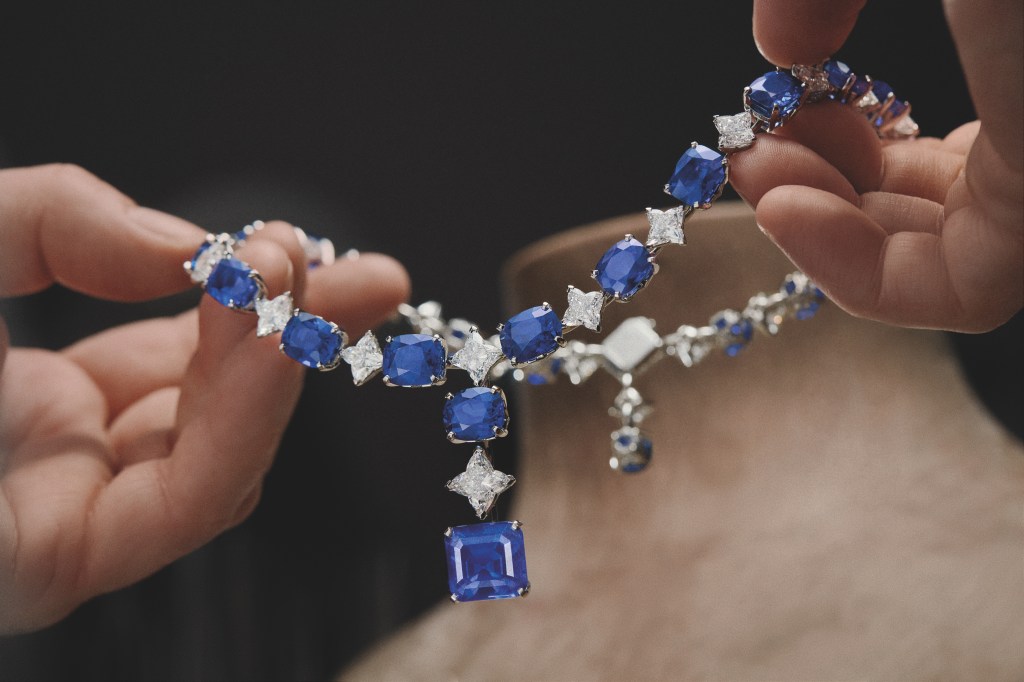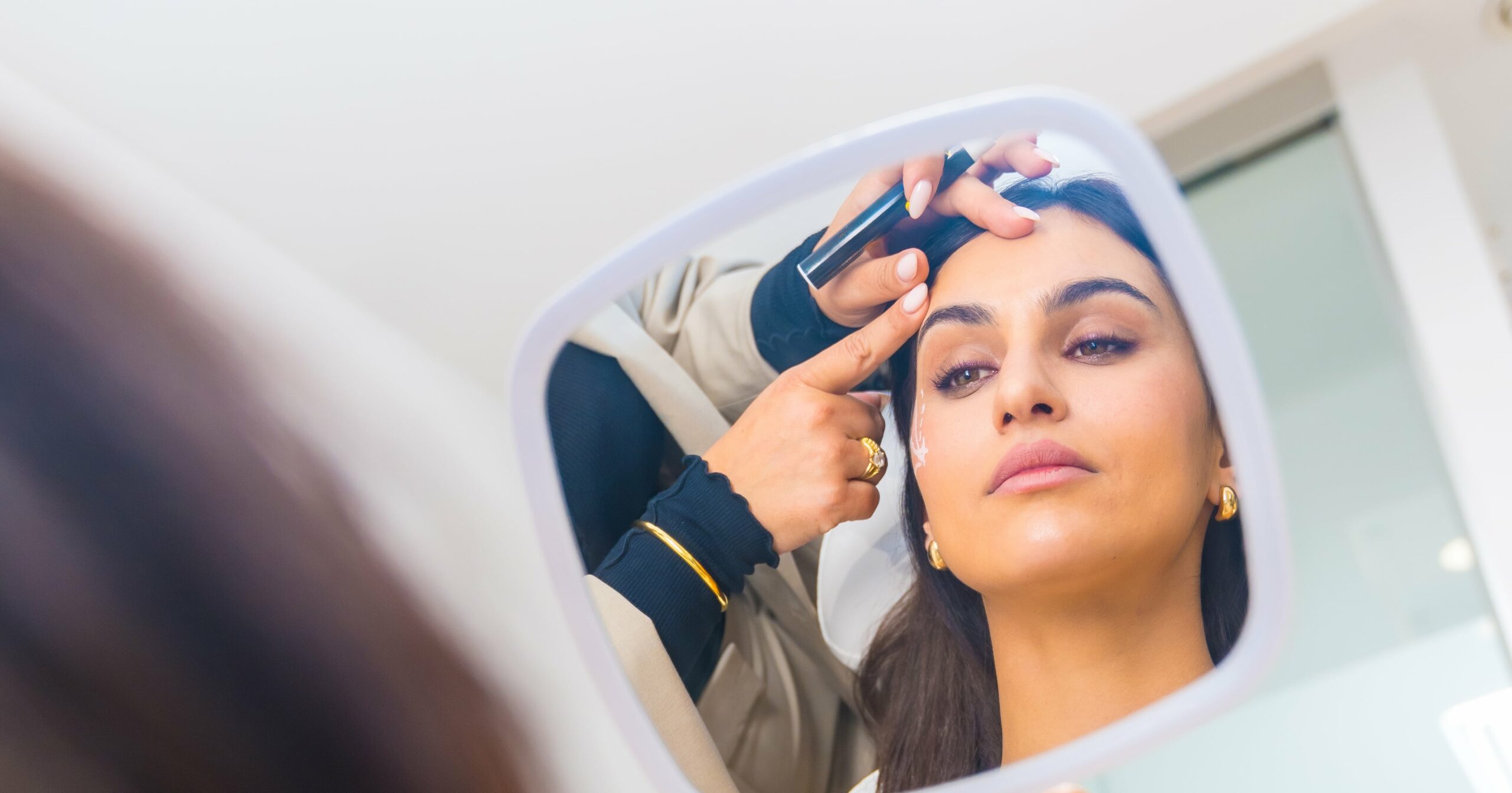PARIS – The suppleness of silk, the delicacy of laces and the possibility of movement floated during Paris Couture Week — on Place Vendôme.
If metal and gemstones aren’t exactly the first materials that come to mind when looking to replicate the feel of fabric, houses plied the considerable skills of their artisans for high jewelry creations that embraced the body like the fashion creations shown on nearby runways.
Take Dior, where Victoire de Castellane applied the principles of couture in “Dior Délicat,” where the feather-light embellishments found in the ateliers and studio of Christian Dior — and Maria Grazia Chiuri, of course — were immortalized in gold and diamonds.
Standing out in the collection was a set where strands of white gold and diamonds festooned around the wrist, neck or the edge of the earlobe in strands of geometric patterns and floral motifs strung together.
A 7-carat pear-cut white diamond was a final precious touch holding all the elements together on that set’s necklace. In another set, the same motifs were harmoniously arranged, intersecting in orderly rows that ended up with juicy vivid yellow diamonds.
The idea of a precious ribbon jauntily drifting at the neck was also captured in a newly presented emerald, sapphire and diamond necklace addition to the Dior Print collection first shown in Taormina, Italy, two years ago.
There was also Boucheron, where artistic director Claire Choisne nodded to ceremonial attire and the textile heritage of founder Frédéric Boucheron with “The Power of Couture,” which featured grosgrain ribbons made of slivers of sanded rock crystal and embroideries of articulated gold and diamonds.
Forget a strand of pearls looped around the neck: for Graff, it’s a diamond-encrusted rope that ends with fancy intense yellow ones that design director Anne-Eva Geoffroy imagined with the stunning stones the British jeweler is known for. Other highlights here included a stylized asymmetric necklace featuring a pair of 4-carat lozenge shaped Colombian emeralds, and a sizable bangle featuring a cushion-cut sapphire that weighed 118 carats.
Other houses went down more metaphorical routes with their allegories.
For Louis Vuitton and its artistic director of watches and jewelry Francesca Amfitheatrof, the way life wove its way through the tectonic upheavals that shaped our planet was at the heart of the 50-piece second chapter of “Deep Time.”
The Myriad necklace and its white gold spines tipped with a diamond alluded to the way DNA underpins the very fabric of life on Earth. But bisected by a spiraling cord that seemed to hold the collar closed, the design also nodded to Vuitton’s history, since ropes are used to transport trunks.
Elsewhere, Amfitheatrof looked at fungi and flora with the puffy volumes of the Symbiosis set and the trio of lush vine leaves dotting a torque that looked like a rolled scarf of the Plants necklace. The latter’s Zambian emeralds, all in custom cuts, had a surprising blue hue to them.
There was also the Skin necklace, where more than 100 pinkish orange Umba sapphires from Tanzania set in a checkerboard design of more than 300 stones nodded to the hides of our most distant ancestors: prehistoric reptiles. But Vuitton’s use of rose gold and the shapely curves of the design also made it seem at once organic and futuristic.
And there is little that feels more fluid than Northern Lights, the dancing phenomena observed in high-latitude regions that inspired the latest David Morris high jewelry collection, named “Skye” after chief executive officer and creative director Jeremy Morris’ youngest daughter.
While the geometries of the Mosaico choker featuring a 15-carat Colombian emerald surrounded by a further 30-plus carats of emeralds and more than 70 carats of diamonds were certainly arresting, the waves and spirals of the Aurora Borealis were best articulated in designs such as the Selene necklace and its sparkling burst of articulated emerald-and-diamond rays.
The idea of movement was furthered by the way the Arctic Dance necklace could be adjusted thanks to the London jeweler’s zip fastening, making this row of diamonds that seemed to drip pink and cobalt blue spinels drape against the neck and collarbones.
And houses are leaning into flexibility in more ways than articulated designs, having made transformability and ease a major feature in high jewelry designs in recent years.
For Chaumet, it meant questioning high jewelry’s necklace-earrings-rings trifecta with a compact “Un Air de Chaumet” offering of four sets of adornments for the head that took cues from birds in flight.
Cue the Ballet brooch-cum-head ornament that figures a flight of swallows in gem-set white and rose gold, or the twinning Envol earcuffs finished with two half-carat pear-shaped diamonds.
As for the Plumes d’Or transformable tiara and its 2.3-carat pear-shaped diamond, which can split into brooches and hair ornaments, it transcribed the intricate structures of plumage in intricately engraved brushed rose gold and pavé white gold.
Nowadays, having one or two ways to wear a jewel is the bare minimum.
Take Cartier’s Muqarna necklace. This graphic array of aquamarines, amethysts, spinels, turquoise and diamonds could be reassembled into no less than nine different configurations that ranged from a short choker to three sizes of brooches.
It was among the new designs continuing the jeweler’s ongoing “Le Voyage Recommencé” high jewelry lineup, where director of high jewelry creation Jacqueline Karachi continues to mine inspirations from nature and world cultures.
From a charmingly realistic “Panthère Confiante,” or confident panther, lounging among juicy peridots and ribbed coral beads to the hexagonal diamond growing into the Pileo ring inspired by a sea urchin and the geometric lines of the Spina and Lerro necklaces, it took the proclivities of the French jeweler even further.
Even so, the streaked turquoise cabochon of its Yfalos necklace was a reminder that jewelers dig ever deeper into the wonders of nature — and treasure troves of unusual gems — for their creations.
Rare indeed are the ones used by Rouvenat, which sources its stones from ancient stocks and forgotten caches sleeping in the coffers of stone dealers. This time, the newly revived brand brought out a 10-carat rock crystal intaglio, indigolite tourmalines and emerald cabochons for its tranformable Bolt necklaces.
It also found an ancient cushion-cut diamond of more than 8 carats on a 19th century jewel that was recast as the center stone on a stunner in its new Frame collection.
Fire opals, a 106-carat blue tourmaline, laguna agates and a turquoise in the softest, milkiest blue were among the gems that Lydia Courteille set in bold yet surprisingly light “Rêves Chamaniques” creations inspired by the traditional arts of the Huichol people of Mexico. Her secret? The use of colorful plique-à-jour enamel that allowed her to create sizable exuberant displays that felt light on the hand or ear.
Gems for Your Bookshelf
“Codognato Masterpiece”

A must-have for connoisseurs, Venetian jeweler Codognato counts the likes of Elizabeth Taylor, Jacqueline Kennedy, Lee Radziwill, Cindy Sherman, Elton John and Maria Grazia Chiuri among its clients and collectors. Written by William Middleton and prefaced by French writer Laurence Benaïm, this richly illustrated tome chronicles the history of the 158-year-old jewelry house, from its inception by art and antiquities merchant Simeone Codognato to the Baroque creations of his late great-grandson Attilio Codognato, who passed the creative reins to Francesca Amfitheatrof.
304 pages, 250 euros
Published by Assouline
“Bäumer: 30 Years of Art”

For the past 30 years, Lorenz Bäumer has cut an iconoclastic figure on Place Vendôme and that’s a story best told by the people who saw the jeweler do it. Friends, clients and even professional rivals come together in this volume to shine a light on how this engineer by training — a graduate of the prestigious Ecole Centrale with a specialty in innovation — put down the bases for high jewelry lines at Louis Vuitton and Chanel, thought up the jewels that captured the hearts of clients like Charlene of Monaco, Alain Ducasse or Diana Picasso and created objects for the likes of Guerlain, Hennessy and Baccarat under his design studio.
184 pages, 50 euros
Published by Abrams
“Lydia Courteille: A Jeweller’s Odyssey”

On tony Rue Saint-Honoré, the window of Lydia Courteille is less a display of her latest precious creations than a portal into the fantastical universe of this expert in jewelry history-turned-gemologist. This second volume penned by Juliet Weir-de La Rochefoucauld dives deeper into Courteille’s colorful creations blending vintage cameos, rare stones from around the world and a rich imagination built on myths, legends and the jeweler’s determination to march to the beat of her own drum always.
388 pages, 45 pounds
Published by ACC Art Books
Skies of Velvet
Long before Francesca Amfithetheatrof turned this set of 23 sapphires into a spectacular bespoke high jewelry design, the gems of the Louis Vuitton Aster necklace lived a life of adventure.
Mined in the Kashmir region over a six-year period starting in 1881, they made their way to Paris where they were cut by Modiano, a famed lapidary who was friends with the territory’s maharaja, in a cushion shape with a brilliant cut on the crown, a step cut for the pavilion and a faceted open culet that brings out a complex nuance to their velvety royal blue.
Fast-forward 100-and-some years: it still took two decades to amass 125 carats’ worth of these gemstones ranging from 2.8 to 17.88 carats.

To bring them to life as “a continuous constellation of spectacular gemstones,” Amfitheatrof interspersed matching 23 LV Monogram Star-cut diamonds totaling 33.18-carats for a design that took six months to finalize and more than 1,500 hours to craft.
“It was an opportunity to design a necklace fit for royalty,” said the French luxury house’s artistic director of watches and jewelry at a viewing. According to one gem specialist, not even Queen Elizabeth II had this many Kashmir sapphires on a single necklace — and the late British sovereign was quite the collector.
So of course, the Aster necklace went to its owner — a long-standing businesswoman client of the French house who agreed to have it shown to press in Paris — in a vivid blue custom trunk befitting this ultimate high jewelry trophy.



